In this article, you’ll learn what is a piston. And how it works, types of pistons, clearance, piston head or shape everything is explained in detail with diagrams.
And also, you can download the free PDF file of this article.
What is a Piston?
The piston is the most essential part of a reciprocating engine. It helps to convert the chemical energy obtained by the combustion of fuel into useful mechanical power.
The piston provides a means of conveying the expansion of the gases to the crankshaft, through the connecting rod, without loss of gas from above or oil from below.

The piston is a cylindrical plug that moves up and down in the cylinder. It has a piston ring to provide a good seal between the piston and cylinder wall. Although the piston seems to be a simple part, it is quite complex from a design standpoint.
The efficiency and economy of the engine depend on the working of the piston. It must operate in the cylinder with minimum friction and it should be able to withstand the high explosive force generated in the cylinder and also the very high temperature ranging from 2,000°C to over 2,800°C during operation.
The piston should be as strong as possible, however, its weight should be minimized as far as possible to reduce the inertia due to its reciprocating mass.
Read also: List of Car Engine Parts: Its Function (With Pictures)
Functions of Piston
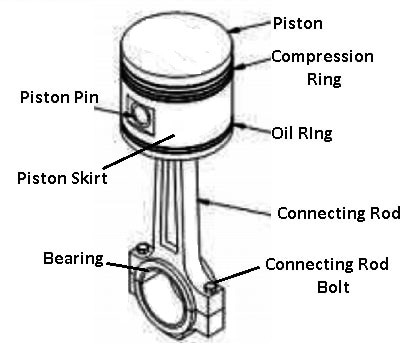
- Receive the thrust produced by the combustion of the gas in the cylinder and transmit it to the connecting rod.
- The piston reciprocates in the cylinder as a gas-tight plug generating suction, compression, expansion, and exhaust strokes.
- The piston forms a guide and bearing to the small end of the connecting rod and takes the side thrust due to the obliquity of the rod.
The top portion of the piston is called the head. Ring grooves are cut on the circumference of the piston’s upper portion of the piston. The parts below the ring grooves are called a skirt. The portions of the piston that separate the grooves are called the lands.
Some pistons have a groove in the top land called a heat dam which reduces heat transfer to the rings. The piston bosses are those reinforced parts of the piston designed to hold the piston pin or wrist pin.
High-Performance Pistons
Aluminum pistons can be either cast or forged. The forged piston is denser and forms a better heat path to allow the heat to get away from the piston head.
It has a grain flow also that improves its wearing ability. The forged aluminum piston is also lighter in comparison with the cast iron piston. Thus it produces lower inertia forces as it accelerates and decelerates in the cylinder.

Considering all these factors together, it can be seen that the forged piston is the preferred piston for high-performance engines. For additional strength, some high-performance pistons also have special skirt configurations. The oval skirt and undulated skirt are designed to provide high strength.
They are used in high-performance automobiles. These are strong enough to be used in competition engines. The piston without board piston-pin bosses is designed for maximum strength and is useful in competition engines.
Types of Pistons
Following are the different types of pistons used in an engine:
- “Lo-Ex” alloy Pistons
- Invar Strut Pistons
- Autothermic Pistons
- Bi-Metal pistons
- Specialloid Pistons
- Wellworthy Pistons
#1 “Lo-Ex” alloy Pistons
Lo-Ex is the name of a light alloy for pistons, signifying low expansion with temperature. It contains the following:
- Silicon 11 to 13%
- Nickel 0.7 to 2.5%
- Magnesium 1%
- Copper 1%
- Aluminum 86.3 to 82.5%
The coefficient of expansion is only about 2% less than that of pure aluminum, but this improvement, combined with good war and heat-resisting qualities makes the alloy a variable one.
#2 Invar Strut Pistons
In this type of piston, Invar is an alloy containing 36% nickel and 64% iron. It has a negligible coefficient of expansion, 000000063 per °C).
Invar struts have been put in the piston connecting the piston pin bosses and the skirt and so proportioned that the resultant expansion of the piston is nearly the same as that of the cylinder.
#3 Autothermic Pistons
These types of pistons contain low-expansion steel inserts at the piston pin bosses. As shown in the figure, these inserts are so molded that their ends are anchored in the piston skirt.
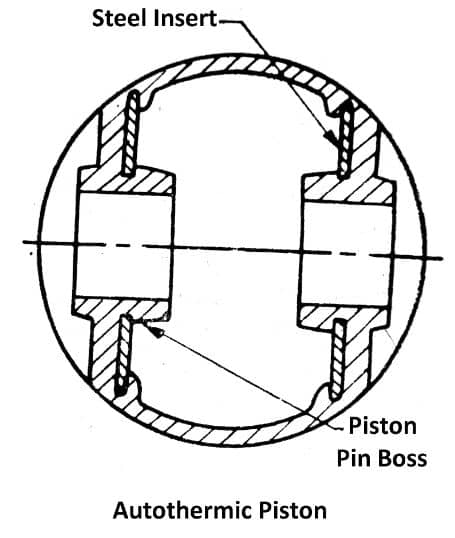
In this case, a bi-metallic distortion due to the different coefficients of expansion of the insert and the parent metal transfers some of the generous initial clearance provided on the gudgeon pin axis to the thrust axis as the piston warms up.
This action enables small clearances to be maintained on the thrust axis in both cold and hot conditions, giving quieter running.
#4 Bi-Metal pistons
These types of pistons are made from both steel and aluminum. An interesting example of the bi-metal construction is the Flower design, as shown in the figure. It consists of a steel skirt and pin basses.
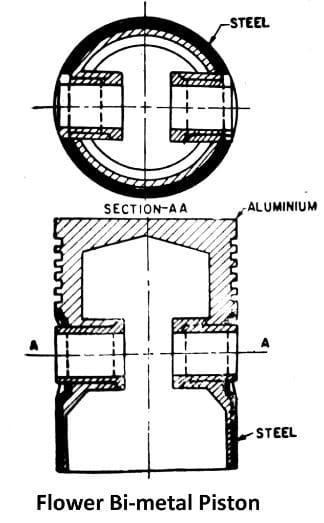
As the coefficient of thermal expansion for steel is quite small, aluminum alloy is cast inside which forms piston head and piston small, the piston will not expand much, and hence smaller cold clearances can be maintained.
It will be seen that the steel skirt while functionally a part of the piston. will have to a considerable being very small and permit small clearances to be used.
#5 Specialloid Pistons
Specialloid production covers a wide range of pistons for zero, automobile petrol engines, and diesel engines as used for commercial vehicles, industrial stationery, rail traction, marine main propulsion, and auxiliary purposes.
The modern specialloid diesel piston has vertical ribs on the internal surface of the skirt and solid piers which take the load directly from the crown to the gudgeon pin bearing area.
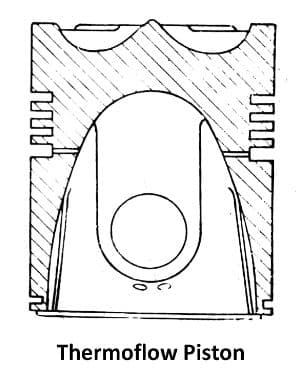
The crown, ring belt, and skirt sections are proportioned to the thermal characteristics, which results in a substantial reduction in operating temperatures, thereby reducing the tendency for ring sticking and distortion of thermal cracking in the region of the valve pockets on the rim of the combustion bowl.
The preferred material is a low expansion high tensile alloy having an 11-12% silicon content referred to as specialloid S. 132. The special thermoflow principle has been adopted in the construction of specialloid pistons, in which there is no abrupt change in the sections that would form a heat flow barrier.
The figure shows a typical heavy-duty Thermoflow piston as used in highly rated diesel engines.
#6 Wellworthy Pistons
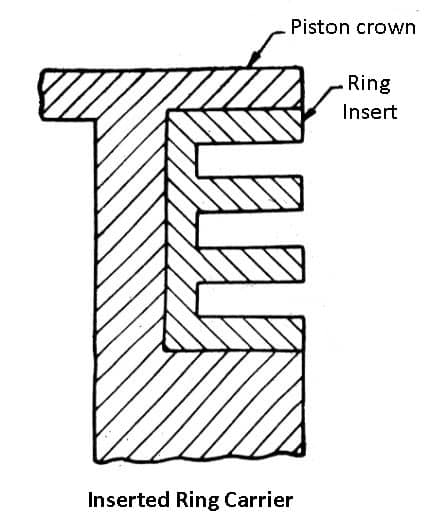
Wellworthy Ltd of Great Britain produces high-duty pistons that will hall have cast iron inserted ring carriers for the top piston rings. These inserted carriers are recently applied to only one ring in the diesel engine piston.
The wear in the top groove is thereby reduced to a minimum as compared with that which it would have been in the unprotected light alloy.
The al-Fin molecular bonding process is utilized in inserting the ring carriers, which prevents any risk of the insert working loose. It also overcomes the great difficulties through oxidation of the aluminum during casting.
In petrol engines where the severity of the working conditions does not justify the use of an insert, successful protection of the grooves has been obtained by the anodizing process.
Qualities of Pistons
- Rigidly to withstand high pressure.
- Lightness reduces the weight of the reciprocating masses and so enables higher engine speeds.
- Good heat conductivity reduces the risk of detonation allowing a higher compression ratio.
- Silence in operation.
- Material having low expansion and provision to allow for different expansion rates of cast iron cylinder block and an aluminum piston.
- Correctly formed skirt to give uniform bearing under working conditions.
Material Used for Piston
The material used for pistons is aluminum alloy. Aluminum pistons can be either cast or forged. Cast iron is also used for the piston. Cast iron is a universal material in the early years because it possesses excellent wearing quality, coefficient of expansion, and general suitability in manufacture.
However, due to the reduction of weight in reciprocating parts, the use of aluminum for pistons was essential. To obtain equal strength a greater thickness of metal is necessary, the same advantage of the light metal is lost.
Aluminum is inferior to cast iron in strength and wearing qualities, and its greater coefficient of expansion necessitates greater clearance in the cylinder to avoid the risk of seizure.
The heat conductivity of aluminum is about three times that of cast iron, and this combined with the greater thickness necessary for strength, enables an aluminum alloy piston to run at much lower temperatures than a cast-iron one (200°C to 250°C as compared with 400° to 450°C).
As a result, carbonized oil does not form on the underside of the piston, and the crankcase, therefore, keeps cleaner. This cool-running property of aluminum is now recognized as being quite as valuable as its lightness indeed, pistons are sometimes made thicker than necessary for strength to give improved cooling.
Piston Clearance
What is piston clearance?
Pistons are normally smaller in diameter than the bore of the cylinder. The area between the cylinder and the cylinder wall is called the piston clearance.
Piston Clearance is Essential for the Following Reasons
- It provides a space for a film of lubricant between the piston and cylinder wall to reduce friction.
- It prevents piston seizure: Due to very high operating temperature, piston and cylinder block expand. The cylinder is getting cooled faster than the piston, hence enough clearance should be given for the piston to expand, failing which the piston seizure will result.
- If there is no clearance between the piston and cylinder, it will be difficult for the piston to reciprocate in the cylinder.
The piston clearance depends upon the size of the cylinder bore and the metal used in the piston. But it is generally 0.025 mm to 0-100 mm. In operation, this clearance is filled with oil so that the piston and rings move on films of oil.
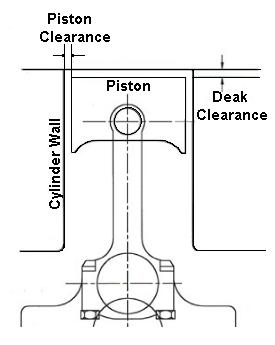
If the clearance is too small, there will be a loss of power from excessive friction, severe wear, and possible seizure of the piston in the cylinder. A piston slap will occur if the piston clearance is too high. A piston slap means sudden tilting of the cylinder as the piston is down on the power stroke.
The piston shifts from one side of the cylinder to the other with sufficient force to produce a distinct noise. As the piston warms up the clearance is reduced and the noise usually disappears. So that fixed clearances may be used without risk of seizure special alloys have been introduced and many designs of the piston are in use.
These special designs involved cam grinding to non-circular forms, semi-flexible skirts incorporating obliques slits, controlled distribution, and the like expedients.
Piston-Head Shape or Piston Crown
The piston head is usually flat but shaped to suit the combustion chamber. The combustion space can be controlled by dishing or doming the piston crown and recess for the valve heads can also be machined into the crown.

The compression ratio can be controlled by machining the combustion chamber in the piston, but it means that most of the heat of combustion has to be consumed through the piston instead of the cylinder head.
Piston-Pin Offset
The piston face that bears most heavily against the cylinder wall during the power stroke is called the major thrust face.
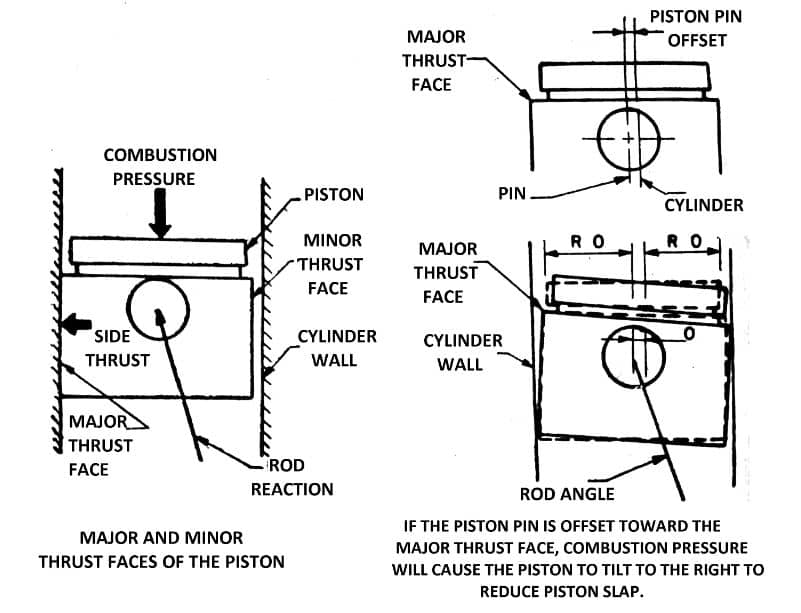
In some engines, the piston pin is offset from the centerline of the piston toward this face. If the piston pin is centered, the minor thrust face will remain in contact with the cylinder wall until the end of the compression stroke.
But the connecting rod-angle changes from left to right as soon as the power stroke starts. This causes a sudden shift of the side thrust on the piston from the minor thrust face to the major thrust face. If there is any appreciable clearance, a piston slap will occur.
But if the piston pin is offset, the combustion pressure will cause the piston to tilt as the piston nears TDC, so that the lower end of the major thrust face will first make contact with the cylinder wall.
Then after the piston passes TDC and the reversal of the side thrust occurs, full major thrust face contacts are made with less tendency of the piston slap to occur.
Expansion Control in Pistons
During operation, the piston runs many degrees hotter than the cylinder, because the cylinder is surrounded by cooling water. Hence this piston expands more than the cylinder. This expansion must be controlled to avoid the loss of adequate piston clearance. Such a loss may cause serious engine trouble.
The problem is more accurate with aluminum pistons because aluminum expands more rapidly than iron with the rise of temperature. The expansion of the piston skirt can be controlled by several methods as follows.
- By keeping heat away from the lower part of the piston.
- By making Heat Dam
- Cam grinding the piston
- By using struts
1. By keeping heat away from the lower part of the piston as much as possible.
This can be done in the full-skirt piston by cutting horizontal slots in the piston just below the lower oil control ring groove. These slots reduce the path for the heat traveling from the cylinder head to the skirt.
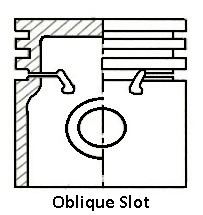
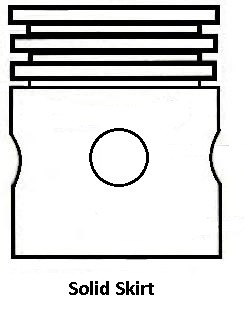
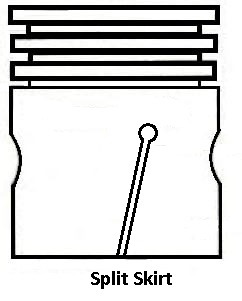
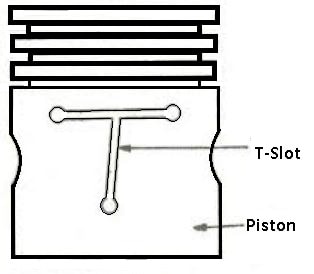
Thus, the skirt does not become so hot and does not expand so much. In some full-skirt pistons, vertical slots are also cut in the skirt, which would allow metal expansion in the skirt, with the appreciable increase of the piston diameter.
2. By making Heat Dam
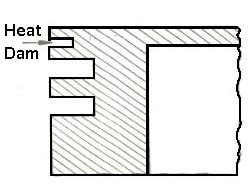
The heat dam has a groove cut near the top of the piston. This reduces the size of the path the heat can travel from the piston head to the skirt. The skirt, therefore, runs cooler and does not expand so much.
3. By cam grinding the piston
The pistons are finished so that they are slightly oval (elliptical) when cold. These pistons are called cam-ground pistons. Its area of contact with the cylinder wall therefore increases.
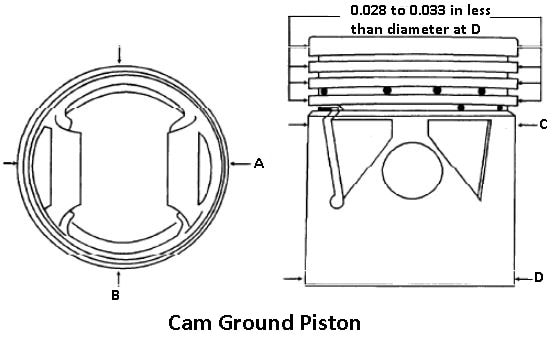
The minor axis of the ellipse lies in the direction of the piston pin axis. More expansion along the minor axis is caused by the piston bosses. Thus, the piston after expansion at functioning temperature becomes circular.
4. By using struts
The piston expansion may also be controlled by using the struts, bands, or belts cast into the piston. These cause the outward thrust of the expanding piston head to be carried more toward the piston-pin bosses than toward the thrust faces so that the effect is similar to that of the cam-ground pistons.
Conclusion
I hope I covered everything about pistons. The piston is one of the most important parts of any engine, if you have any questions about “types of pistons” you can ask us in the comments I’ll respond to you. If you like this article on types of pistons then please share it with your friends.
Subscribe to our newsletter to get notification of our new posts.
You can download the PDF file by clicking below.
That’s it, Thanks for reading.
Read Next:
nice one thanks
Welcome.
Thankz for the info on types of piston.
You’re welcome